Automotive XR (Extended Reality) is an innovative technology that integrates VR (Virtual Reality), AR (Augmented Reality) and MR (Mixed Reality) technologies into vehicle systems. It can bring drivers and passengers richer and more intuitive information interaction experiences. It is an important embodiment of differentiation between intelligent cockpits of the future.???
XR is integrated with IVI and smartphones to create multi-terminal integration experience.
In March 2023, Rokid and Li Auto announced Rokid Max, their cooperative AR glasses which support L series models. Li Auto’s IVI APP can be projected onto VR glasses for viewing, gaming, online office, etc. In addition, it allows handheld game consoles to be projected onto the center console screen and then to the glasses, so that users can control IVI and play games through gesture interaction.???
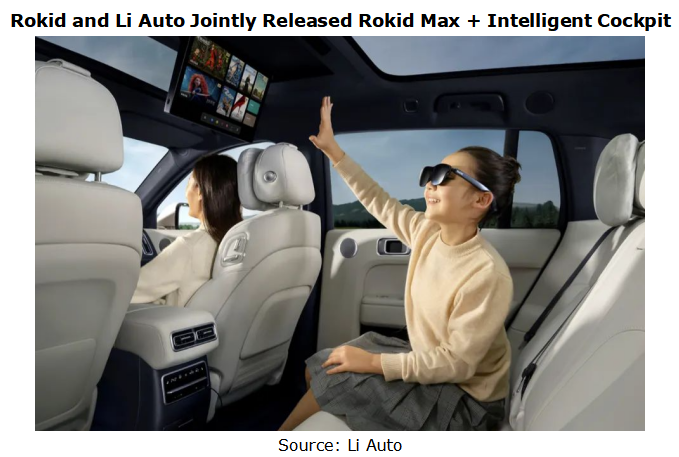
In November 2023, Xingji Meizu released MYVU intelligent AR glasses based on Flyme AR OS. The integration with Meizu smartphones via Flyme Link (a smartphone-IVI integration solution) not only allows for circulation of phone calls, music, videos, navigation, important application notifications and more to the AR glasses, but also makes it share computing power and network with the smartphone, thereby reducing the power consumption of the glasses and enabling a long cruising range. In the future, MYVU AR glasses will be integrated with cars and smartphones to create multi-terminal integration experience through seamless flow of applications and data.??
?
Therefore, at the “Meizu Flyme Ecosystem Launch”, Xingji Meizu upgraded the operating system Flyme to FlymeOS. Composed of Flyme 10 (smartphone OS), Flyme Auto (Meizu IVI system), and Flyme AR (AR glasses OS), FlymeOS covers three major areas: smartphone, XR and intelligent vehicle. FlymeOS features "Internet of Everything, Boundless and Infinite", and becomes the base for connecting all terminals.?????
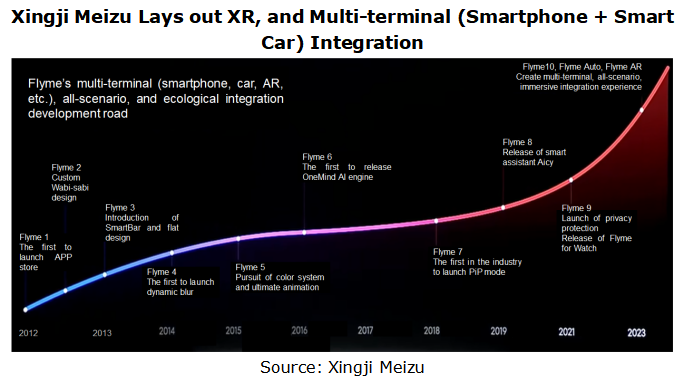
AI+AR to enhance voice interaction experience
?
At CES 2024, Rayneo unveiled Rayneo X2 Lite, a stereo full-color MicroLED optical waveguide AR glasses that introduce Rayneo AI (released in December 2023), a foundation model voice assistant. With Rayneo AI, Rayneo X2 Lite enables multiple capabilities including multi-round natural language conversations, trip planning, easy encyclopedic Q&A and brainstorming, and supports AI-assisted translation, 3D spatial navigation, and first-person perspective video creation. In March 2024, Rayneo Technology closed a new funding round and raised RMB100 million which will be used to develop and spawn next-generation AR glasses and expedite the construction of the AI+AR glasses ecosystem.????
Xingji Meizu is also laying out AI+AR. In November 2023, Xingji Meizu released two MYVU series AR glasses, connected to the Flyme AI foundation model. Based on AI, AI assistant can be awakened in real time to provide travel tips, study plans, business analysis, and other daily life and work collaboration. At the same time, AR glasses can realize scenario functions such as teleprompter, real-time translation (in Chinese and English), and cycling navigation.
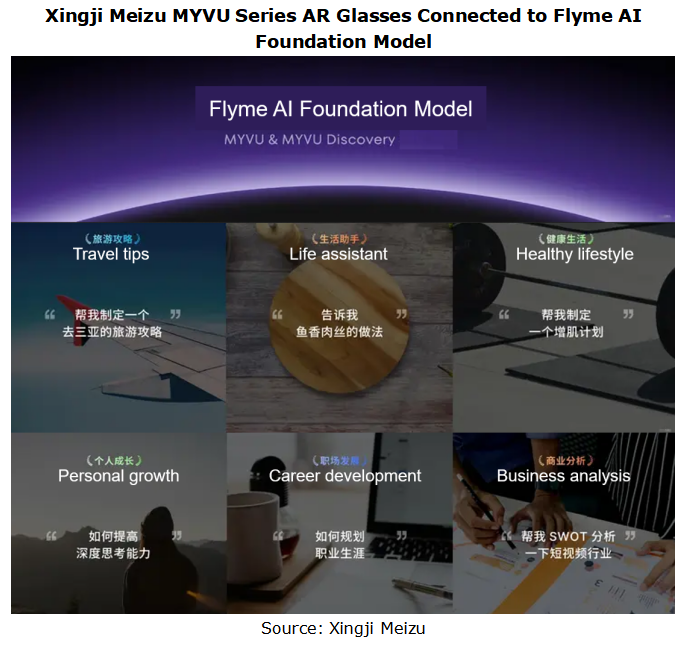
Automotive XR scenarios expand from entertainment to driving assistance and vehicle control.
Currently, XR mainly caters to users’ needs for cockpit entertainment, for example, viewing and gaming. Moreover suppliers are also exploring other application scenarios such as driving assistance and vehicle control.?
?
At CES 2024, BMW and XREAL together demonstrated XREAL Air 2 AR glasses, a device which integrates vehicle information, infotainment, vehicle electronic and electrical information, BMW cloud information and other data. Wearing the glasses, users can see how navigation instructions, hazard warnings, entertainment content, information on charging stations and supporting visualizations in parking situations are embedded perfectly into the real-world environment by the “XREAL Air 2”.???
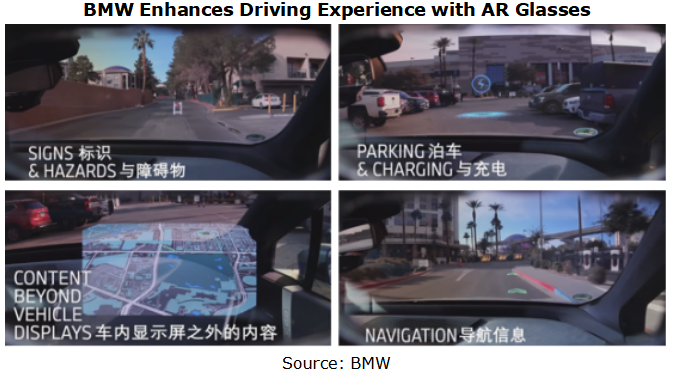
?
At CES 2023, Audi presented activesphere, a concept car which is equipped with four AR headsets. Wearing Magic Leap 2 AR glasses, the driver can view trip data, road conditions, location and navigation information in real time the MR visual interface with a 70° FOV; the passengers can control air conditioning temperature, airflow, and audio system next to their seats via gestures.??
?
Furthermore, AR technology can be available beyond the cockpit. In off-road scenarios, the topographic map can be projected into the surroundings; in commuting, traffic information, routes and safety warnings can be projected in layers into the driver's view.????
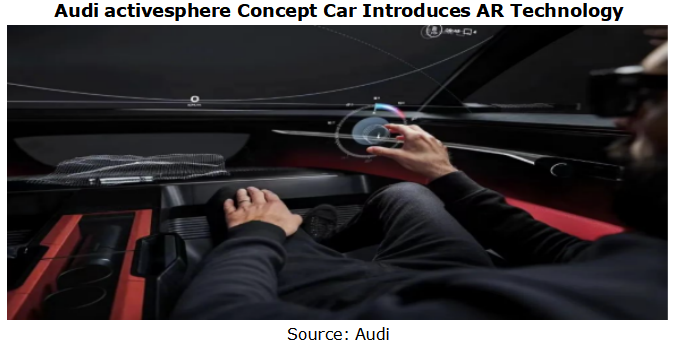 ?
?
?
Autonomous Driving Domain Controller and Central Computing Unit (CCU) Industry Report, 2025
Research on Autonomous Driving Domain Controllers: Monthly Penetration Rate Exceeded 30% for the First Time, and 700T+ Ultrahigh-compute Domain Controller Products Are Rapidly Installed in Vehicles
L...
China Automotive Lighting and Ambient Lighting System Research Report, 2025
Automotive Lighting System Research: In 2025H1, Autonomous Driving System (ADS) Marker Lamps Saw an 11-Fold Year-on-Year Growth and the Installation Rate of Automotive LED Lighting Approached 90...
Ecological Domain and Automotive Hardware Expansion Research Report, 2025
ResearchInChina has released the Ecological Domain and Automotive Hardware Expansion Research Report, 2025, which delves into the application of various automotive extended hardware, supplier ecologic...
Automotive Seating Innovation Technology Trend Research Report, 2025
Automotive Seating Research: With Popularization of Comfort Functions, How to Properly "Stack Functions" for Seating?
This report studies the status quo of seating technologies and functions in aspe...
Research Report on Chinese Suppliers’ Overseas Layout of Intelligent Driving, 2025
Research on Overseas Layout of Intelligent Driving: There Are Multiple Challenges in Overseas Layout, and Light-Asset Cooperation with Foreign Suppliers Emerges as the Optimal Solution at Present
20...
High-Voltage Power Supply in New Energy Vehicle (BMS, BDU, Relay, Integrated Battery Box) Research Report, 2025
The high-voltage power supply system is a core component of new energy vehicles. The battery pack serves as the central energy source, with the capacity of power battery affecting the vehicle's range,...
Automotive Radio Frequency System-on-Chip (RF SoC) and Module Research Report, 2025
Automotive RF SoC Research: The Pace of Introducing "Nerve Endings" such as UWB, NTN Satellite Communication, NearLink, and WIFI into Intelligent Vehicles Quickens
RF SoC (Radio Frequency Syst...
Automotive Power Management ICs and Signal Chain Chips Industry Research Report, 2025
Analog chips are used to process continuous analog signals from the natural world, such as light, sound, electricity/magnetism, position/speed/acceleration, and temperature. They are mainly composed o...
Global and China Electronic Rearview Mirror Industry Report, 2025
Based on the installation location, electronic rearview mirrors can be divided into electronic interior rearview mirrors (i.e., streaming media rearview mirrors) and electronic exterior rearview mirro...
Intelligent Cockpit Tier 1 Supplier Research Report, 2025 (Chinese Companies)
Intelligent Cockpit Tier1 Suppliers Research: Emerging AI Cockpit Products Fuel Layout of Full-Scenario Cockpit Ecosystem
This report mainly analyzes the current layout, innovative products, and deve...
Next-generation Central and Zonal Communication Network Topology and Chip Industry Research Report, 2025
The automotive E/E architecture is evolving towards a "central computing + zonal control" architecture, where the central computing platform is responsible for high-computing-power tasks, and zonal co...
Vehicle-road-cloud Integration and C-V2X Industry Research Report, 2025
Vehicle-side C-V2X Application Scenarios: Transition from R16 to R17, Providing a Communication Base for High-level Autonomous Driving, with the C-V2X On-board Explosion Period Approaching
In 2024, t...
Intelligent Cockpit Patent Analysis Report, 2025
Patent Trend: Three Major Directions of Intelligent Cockpits in 2025
This report explores the development trends of cutting-edge intelligent cockpits from the perspective of patents. The research sco...
Smart Car Information Security (Cybersecurity and Data Security) Research Report, 2025
Research on Automotive Information Security: AI Fusion Intelligent Protection and Ecological Collaboration Ensure Cybersecurity and Data Security
At present, what are the security risks faced by inte...
New Energy Vehicle 800-1000V High-Voltage Architecture and Supply Chain Research Report, 2025
Research on 800-1000V Architecture: to be installed in over 7 million vehicles in 2030, marking the arrival of the era of full-domain high voltage and megawatt supercharging.
In 2025, the 800-1000V h...
Foreign Tier 1 ADAS Suppliers Industry Research Report 2025
Research on Overseas Tier 1 ADAS Suppliers: Three Paths for Foreign Enterprises to Transfer to NOA
Foreign Tier 1 ADAS suppliers are obviously lagging behind in the field of NOA.
In 2024, Aptiv (2.6...
VLA Large Model Applications in Automotive and Robotics Research Report, 2025
ResearchInChina releases "VLA Large Model Applications in Automotive and Robotics Research Report, 2025": The report summarizes and analyzes the technical origin, development stages, application cases...
OEMs’ Next-generation In-vehicle Infotainment (IVI) System Trends Report, 2025
ResearchInChina releases the "OEMs’ Next-generation In-vehicle Infotainment (IVI) System Trends Report, 2025", which sorts out iterative development context of mainstream automakers in terms of infota...